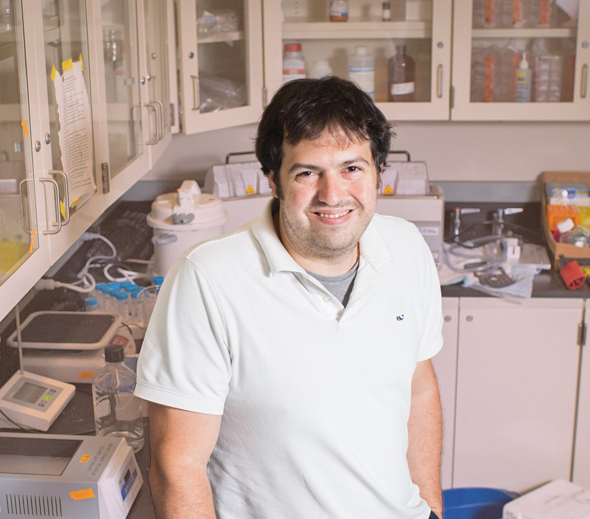NIH grant enables Albro and team to advance first-in-kind scope for early detection of osteoarthritis
By Patrick L. Kennedy
It’s a disease that causes pain, can’t be cured right now, and can’t be diagnosed until it’s too late. But with a research grant from the National Institutes of Health, a team of BU engineers collaborating with clinicians and other experts around the world is developing a groundbreaking weapon in the fight against osteoarthritis (OA).
“We keep getting contacted by orthopedic surgeons in the area who really want to use this in the clinic as soon as possible,” says Assistant Professor Michael Albro (ME, MSE, BME), who is the lead PI in an ongoing project to build a noninvasive, light-based arthroscope to gauge the health of cartilage in the knees and other joints. Totaling nearly $3 million, “this NIH grant will essentially enable us to prove that Raman diagnostic measurements can outperform MRI.”

A degenerative joint disease that afflicts 32.5 million Americans, OA occurs when articular cartilage—the tissue that cushions the ends of bones at the joint—wears away. It leads to pains and aches and even disability. The tissue loss is irreversible, so eventually an artificial joint is required. That’s a problem when the OA sufferer is a young adult or even a teenager, because artificial joints only last for a couple of decades.
“When you think of osteoarthritis, you think of older individuals, but the reality is that 24 percent of adults are afflicted with osteoarthritis,” says Albro. “The burden can at times fall even heavier on younger patients.” Every year, hundreds of thousands of adolescents and young adults suffer sports injuries that can lead to post-traumatic osteoarthritis, says Albro. “And they’re not yet eligible for a joint replacement procedure.”
Soft tissue doesn’t show up very well in MRI or radiography scans, meaning no method currently in use can detect OA early, when there might still be time to intervene. The alternative that Albro and colleagues have crafted uses the principle of Raman scattering. Long in use to date fossils and bust art forgers, a Raman spectroscope shines light on a specimen, counts the tiny number of light particles that undergo a shift in wavelength, and uses that data to assess the specimen’s chemical composition.
Applying this process to articular cartilage, Albro’s team figured out that Raman scattering would pick up on key biomarkers, measuring the tissue’s composition as well as its mechanical function. With a grant from the Arthritis Foundation, they successfully tested their device—the first-ever Raman arthroscope—in explants in 2021. Now, with the NIH R01 grant, they are testing it in live large animal models, bringing the technology another step closer to the clinic.
Why build a better arthroscope if cartilage loss can’t be reversed? Two good reasons. First, many scientists are in fact working on methods that might stop OA in its tracks—and some even hope to reverse it—so if the disease could be detected early enough, that would prevent a lot of damage from ever occurring.
Secondly, many researchers are working on engineering or regenerating tissue to replace the cartilage. Indeed, Albro and many of his colleagues on the Raman arthroscope project are also involved in just such efforts, as part of a two-pronged approach: Their “optical biopsy” device can be used to assess the quality of the replacement tissue that they and others engineer, just as well as it can assess natural tissue.
“Ultimately, one of the key benefits of the [Raman] technology is going to be, for the first time ever, to examine the efficacy of some of these exciting emerging therapies,” says Albro.
The team includes Professor Mark Grinstaff (BME, Chemistry, MSE, MED); Research Professor Brian Snyder (BME), who is also an orthopedic surgeon at Boston Children’s Hospital; and biophotonics expert Mads Bergholt from King’s College in London, among others—as well as “just terrific, talented students” from all three ENG departments, says Albro.
“These are challenging problems that any one of us sitting alone would really not be able to tackle,” says Albro. “These international, interdisciplinary collaborations are wonderful—but they can also be precarious, given the distance and everyone’s busy schedules. So the magic formula is, you have to really like working together. And we seem to have found this really nice team that’s just really enthusiastic to work together on these projects.”
